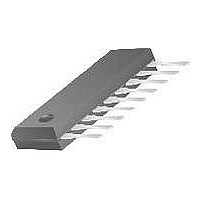FSFR1600XS Fairchild Semiconductor, FSFR1600XS Datasheet - Page 9

FSFR1600XS
Manufacturer Part Number
FSFR1600XS
Description
IC FPS PWR SWITCH 160W 9-SIP
Manufacturer
Fairchild Semiconductor
Series
FPS™r
Datasheet
1.FSFR1600XS.pdf
(14 pages)
Specifications of FSFR1600XS
Output Isolation
Isolated
Frequency Range
94kHz ~ 106kHz
Voltage - Input
9.6 V ~ 25 V
Voltage - Output
500V
Power (watts)
160W
Operating Temperature
-40°C ~ 130°C
Package / Case
9-SSIP
Output Voltage
500 V
Output Power
160 W
Input Voltage
9.6 V to 25 V
Switching Frequency
100 KHz
Operating Temperature Range
- 40 C to + 130 C
Mounting Style
Through Hole
Duty Cycle (max)
50 %
Number Of Outputs
1
Lead Free Status / RoHS Status
Lead free / RoHS Compliant
© 2010 Fairchild Semiconductor Corporation
FSFR-XS Series • Rev.1.0.1
Functional Description
1. Basic Operation. FSFR-XS series is designed to
drive high-side and low-side MOSFETs complementarily
with 50% duty cycle. A fixed dead time of 350ns is
introduced between consecutive transitions, as shown in
Figure 15.
2. Internal Oscillator: FSFR-XS series employs a
current-controlled oscillator, as shown in Figure 16.
Internally, the voltage of R
charging / discharging current for the oscillator capacitor,
C
R
switching frequency increases as I
3. Frequency Setting: Figure 17 shows the typical
voltage gain curve of a resonant converter, where the
gain is inversely proportional to the switching frequency
in the ZVS region. The output voltage can be regulated
by modulating the switching frequency. Figure 18 shows
the typical circuit configuration for the R
opto-coupler transistor is connected to the R
modulate the switching frequency.
The minimum switching frequency is determined as:
Assuming
transistor is 0.2V, the maximum switching frequency is
determined as:
f
f
T
T
min
max
, is obtained by copying the current flowing out of the
pin (I
=
=
5.2
(
Figure 16. Current-Controlled Oscillator
Figure 15. MOSFETs Gate Drive Signal
5.2
R
R
min
CTC
k
min
Ω
k
the
Ω
) using a current mirror. Therefore, the
×
+
100(
4.68
saturation
R
kHz
max
k
Ω
)
) 100(
×
T
pin is regulated at 2V and the
voltage
kHz
CTC
)
increases.
of
T
pin, where the
opto-coupler
T
pin to
(1)
(2)
9
To prevent excessive inrush current and overshoot of
output voltage during startup, increase the voltage gain
of the resonant converter progressively. Since the
voltage gain of the resonant converter is inversely
proportional to the switching frequency, the soft-start is
implemented by sweeping down the switching frequency
from an initial high frequency (f
voltage is established. The soft-start circuit is made by
connecting R-C series network on the R
in Figure 18. FSFR-XS series also has a 3ms internal
soft-start to reduce the current overshoot during the initial
cycles, which adds 40kHz to the initial frequency of the
external soft-start circuit, as shown in Figure 19. The
initial frequency of the soft-start is given as:
f
Figure 17. Resonant Converter Typical Gain Curve
ISS
=
(
R
5.2
Figure 18. Frequency Control Circuit
R
max
min
k
Ω
+
R
5.2
min
R
k
SS
Ω
) 100 40 (
R
C
×
ss
ss
+
CS
AR
I S S
R
T
kHz
) until the output
SG
LV
T
)
CC
pin, as shown
www.fairchildsemi.com
VDL
PG
(3)












